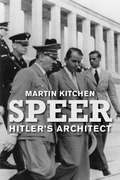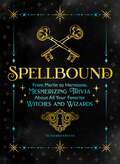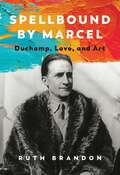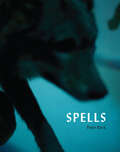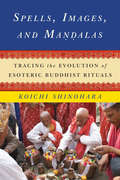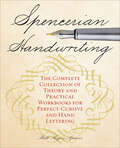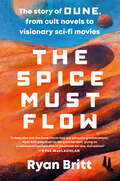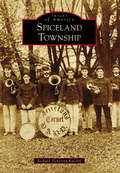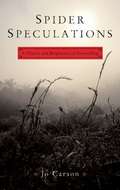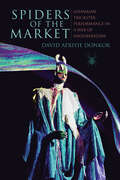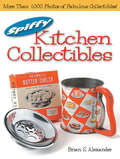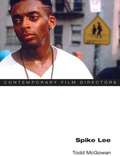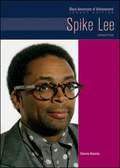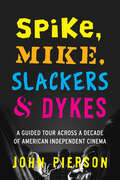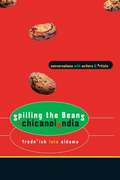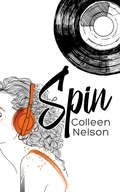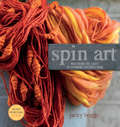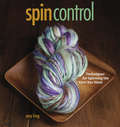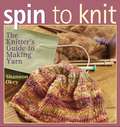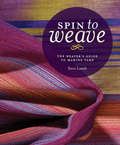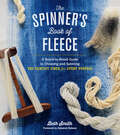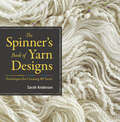- Table View
- List View
Speer: Hitler's Architect
by Martin Kitchen&“Sets the record straight on Albert Speer&’s assertions of ignorance of the Final Solution and claims to being the &‘good Nazi.&’&”—Kirkus Reviews In his bestselling autobiography, Albert Speer, Minister of Armaments and chief architect of Nazi Germany, repeatedly insisted he knew nothing of the genocidal crimes of Hitler&’s Third Reich. In this revealing new biography, author Martin Kitchen disputes Speer&’s lifelong assertions of ignorance and innocence, portraying a far darker figure who was deeply implicated in the appalling crimes committed by the regime he served so well. Kitchen reconstructs Speer&’s life with what we now know, including information from valuable new sources that have come to light only in recent years. The result is the first truly serious accounting of the man, his beliefs, and his actions during one of the darkest epochs in modern history, not only countering Speer&’s claims of non-culpability but also disputing the commonly held misconception that it was his unique genius alone that kept the German military armed and fighting long after its defeat was inevitable. &“A devastating portrait of an empty, narcissistic and compulsively ambitious personality.&”—The Wall Street Journal &“Kitchen&’s exhaustively researched, detailed book nails, one by one, the lies of the man who provided a thick coat of whitewash to millions of old Nazis. Its fascinating account of how the moral degradation of the chaotic Nazi regime corrupted an entire nation is a timely warning for today.&”—Daily Mail (&“Book of the Month&”) &“[An] excellent new biography . . . Kitchen has taken a wrecking ball to Speer&’s mendacious and meticulously created self-image. And about time, too.&”—History Today
Spellbound: From Merlin to Hermione, Mesmerizing Trivia About All Your Favorite Witches and Wizards
by Winifred Owens1,001 beguiling facts for fans of witchcraft and wizardryConjure the secrets of your favorite magical tales with Spellbound. This charming trivia compendium is brimming with captivating facts, sneaky Easter eggs, and illuminating behind-the-scenes moments from mystical literature, games, comics, TV, and movies. Discover the Grimm inspiration behind Disney’s fairy tales, the tequila-soaked secrets of Practical Magic, the real magic of Hocus Pocus, the ties that bind Sabrinas, the dramatic origin story of Dungeons & Dragons, and so much more. As you trace magic through time and cultures, you may even find new champions of enchantment to admire.- Unveil 1,001 dazzling details about the sorcerers and enchantresses of legend, literature, and modern media- Celebrate fantastical characters across pop culture, from wicked witches and weary wizards to benevolent spellcasters and magical creatures- Explore insights into the magical writers, actors, and creators who have bewitched us al
Spellbound by Marcel: Duchamp, Love, and Art
by Ruth BrandonIn 1913 Marcel Duchamp's Nude Descending a Staircase exploded through the American art world. This is the story of how he followed the painting to New York two years later, enchanted the Arensberg salon, and—almost incidentally—changed art forever. In 1915, a group of French artists fled war-torn Europe for New York. In the few months between their arrival—and America&’s entry into the war in April 1917—they pushed back the boundaries of the possible, in both life and art. The vortex of this transformation was the apartment at 33 West 67th Street, owned by Walter and Louise Arensberg, where artists and poets met nightly to talk, eat, drink, discuss each others&’ work, play chess, plan balls, organise magazines and exhibitions, and fall in and out of love. At the center of all this activity stood the mysterious figure of Marcel Duchamp, always approachable, always unreadable. His exhibit of a urinal, which he called Fountain, briefly shocked the New York art world before falling, like its perpetrator, into obscurity. Many people (of both sexes) were in love with Duchamp. Henri-Pierre Roché and Beatrice Wood were among them; they were also, briefly, and (for her) life-changingly, in love with each other. Both kept daily diaries, which give an intimate picture of the events of those years. Or rather two pictures—for the views they offer, including of their own love affair, are stunningly divergent. Spellbound by Marcel follows Duchamp, Roché, and Beatrice as they traverse the twentieth century. Roché became the author of Jules and Jim, made into a classic film by François Truffaut. Beatrice became a celebrated ceramicist. Duchamp fell into chess-playing obscurity until, decades later, he became famous for a second time—as Fountain was elected the twentieth century&’s most influential artwork.
Spells: A Novel Within Photographs
by Peter RockTwenty years ago, while working as a security guard in an art museum, Peter Rock staved off the job's inherent boredom and loneliness by trying to make up a story for each photograph, painting and object in the museum. A few years ago, reminded of the pleasures and play that he felt in danger of forgetting, he began to envision a similar project.As he explains, "First, I found photographers whose work I was drawn to, and contacted them with a very hypothetical and tentative description of what I was doing. Somewhat arbitrarily, I decided that five photographers would be a good number; I was gratified that the first five I contacted were excited to join me. Next, I let these photographers know why I was drawn to their work, noted some images I really admired, and shared some of my previous writing with them. I asked them to send me 20–30 images; of these, I chose five at a time, and proceeded incrementally, generating the specific stories as I went.The images are not merely illustrations for a pre–existent story, then, but the conditions and possibilities and limitations of how they proceeded. The images came first. One way to think of it is that the stories herein, and the larger story they become, were already embedded in the photographs. My attention and intuition acted as a kind of excavation that brought them to the surface, into words."The texts range from narrative to prose poem, from folktale to rant to reverie to an essay written by a fourth grader. The overarching story follows three friends who have recently graduated from high school; it explores their relationships and how things change when they become entangled with an elderly widower who claims to have dreamt of one of them. The ensuing drama explores the relationship between dreams and waking life, between the head and the heart, between shadows and their bodies, between the living and the dead.
Spells, Images, and Mandalas: Tracing the Evolution of Esoteric Buddhist Rituals (The Sheng Yen Series in Chinese Buddhist Studies)
by Koichi ShinoharaKoichi Shinohara traces the evolution of Esoteric Buddhist rituals from the simple recitation of spells in the fifth century to complex systems involving image worship, mandala initiation, and visualization practices in the ninth century. He presents an important new reading of a seventh-century Chinese text called the Collected Dharani Sutras, which shows how earlier rituals for specific deities were synthesized into a general Esoteric initiation ceremony and how, for the first time, the notion of an Esoteric Buddhist pantheon emerged.In the Collected Dharani Sutras, rituals for specific deities were typically performed around images of the deities, yet Esoteric Buddhist rituals in earlier sources involved the recitation of spells rather than the use of images. The first part of this study explores how such simpler rituals came to be associated with the images of specific deities and ultimately gave rise to the general Esoteric initiation ceremony described in the crucial example of the All-Gathering mandala ritual in the Collected Dharani Sutras. The visualization practices so important to later Esoteric Buddhist rituals were absent from this ceremony, and their introduction would fundamentally change Esoteric Buddhist practice. This study examines the translations of dharani sutras made by Bodhiruci in the early eighth century and later Esoteric texts, such as Yixing's commentary on the Mahavairocana sutra and Amoghavajra's ritual manuals, to show how incorporation of visualization greatly enriched Esoteric rituals and helped develop elaborate iconographies for the deities. Over time, the ritual function of images became less certain, and the emphasis shifted toward visualization. This study clarifies the complex relationship between images and ritual, changing how we perceive Esoteric Buddhist art as well as ritual.
Spencerian Handwriting: The Complete Collection of Theory and Practical Workbooks for Perfect Cursive and Hand Lettering
by Platt Rogers SpencerThe first all-in-one edition of P.R. Spencer’s classic penmanship primer including step-by-step lessons and pages for practicing.Easy to understand yet challenging to perfect, the Spencerian system was the standard for all personal and business correspondence in the 1800s. While modern students are barely taught cursive, for more than a century schoolchildren were dutifully drilled in intricate penmanship using this original primer.Now you can follow the step-by-step instructions and practice on the included workbook pages to learn:• The seven Spencerian principles• Proper pen positioning• Finger and arm movement• Heights and widths of letters• Spacing between letters and words• Optional shading effectsWith Spencerian Handwriting, you can add a personal touch to all your handwritten letters and notes reminiscent of simpler, more elegant times.
Spencerian Penmanship Practice Book: Example Sentences with Workbook Pages
by Schin LoongPractice makes perfect!It’s no secret that improving your Spencerian penmanship requires practice. Unfortunately, Platt Rogers Spencer published less than 30 Spencerian practice sentences. That’s why this helpful workbook offers over 180 pages of all-new phrases and sentences for you to refine your lettering.Across the top of each page is carefully composed Spencerian lettering by penman Schin Loong. Below the sample sentence is line after line of practice space where you can master your letter height, width, spacing, stroke weight and more. The pages are even perforated so it is easy for you to tear them out and practice on a perfectly at surface. But this book contains no ordinary words—they are the immortal phrases from the Declaration of Independence that define freedom and liberty, such as “We hold these truths to be self evident that all men are created equal.”
The Spice Must Flow: The Story of Dune, from Cult Novels to Visionary Sci-Fi Movies
by Ryan BrittGeek-culture expert Ryan Britt takes us behind the pages and scenes of the science-fiction phenomenon Dune, charting the series' life from cult sci-fi novels to some of the most visionary movies of all time. Using original, deep-access reporting, extensive research, and insightful commentary, The Spice Must Flow brings the true popularity of Dune out into the light for the very first time. With original interviews with the beloved actors and directors behind the films—including Timothée Chalamet, Kyle Maclachlan, Denis Villeneuve, Patrick Stewart, Rebecca Ferguson, Alec Newman, and many more— The Spice Must Flow also examines the far-reaching influence of Dune on art, music, politics, and, most notably, its status as the first ecological science-fiction story specifically concerned with climate change. Britt skillfully and entertainingly guides readers through the history of how the Dune universe has unfolded, including the novel&’s unlikely evolution from a failed piece of journalism about Oregon sand dunes into an epic science-fiction story, the way Herbert&’s work inspired George Lucas, untold stories from the 1984 David Lynch film, the knife-edge balance between blockbuster hit and indie film Timothée Chalamet brings to the 2021 movie, and the exciting future of the franchise. Through a blend of narrative, oral history elements, and fascinating trivia, The Spice Must Flow is the new essential guide to the behind-the-scenes story of Dune. The fiction of Dune is deadly serious, but the real-life story of how it came into existence is full of wonder, surprises, and spice.
Spiceland Township
by Richard Pickering RatcliffSpiceland Township and the town of Spiceland are truly unique in that no other township, town, or city in the United States has the same name. Native Americans were first attracted to the area because of the abundance of springs along the classic little stream called Brook Bezor. From 1870 to 1921, Spiceland was known for its Friends (Quaker) Academy. The Spiceland Sanitarium also attracted visitors from all over the country. In pre-Civil War days, the township was a prominent station on the Underground Railroad. Spiceland Academy (later Spiceland High School) turned out a number of outstanding graduates, including playwrights, lyricists, inventors, entrepreneurs, authors, and college presidents. Spiceland's Draper Inc. is the largest factory of its kind in the United States and the largest industry in Henry County.
Spider Speculations
by Jo Carson"I've spent about 15 years plus some working with people's stories in a series of communities in this country. I write plays from oral histories for those communities. Just finished my 30th. I'm watching people's lives and communities literally change, sometimes drastically, for the work. Spider Speculations is the beginning of trying to understand the hows and whys of all the changes."--Author Jo CarsonJo Carson lays bare her personal investigation into her own creative process after a spider bite on her back begins a series of life-altering events. Spider Speculations applies cutting edge mind-body science, quantum physics and ancient shamanistic techniques to describe how stories work in our bodies and our lives, and what happens when real stories are used in a public way. Carson, whose ability to capture the spoken word hallmarks her community-based work, sets down this story in her own distinctive voice, interspersing the journey with examples of her performance work. This truly original American book will speak to anyone thinking about art and community or engaging with people's stories.Jo Carson is a writer and performer living in John City, Tennessee. She has published award-winning plays, short stories, children's books, essays, poems and other work. Her play Whispering to Horses and solo show If God Came Down...premiered at Seven Stages in Atlanta. She currently performs Liars, Thieves, and Other Sinners on the Bench, made up of selected stories from her oral history plays, which will be published by TCG in 2007.
Spiders of the Market: Ghanaian Trickster Performance in a Web of Neoliberalism (African Expressive Cultures)
by David Afriyie DonkorAn analysis of the trickster spider character from West African folklore, performance, and Ghanian politics.The Ghanaian trickster-spider, Ananse, is a deceptive figure full of comic delight who blurs the lines of class, politics, and morality. David Afriyie Donkor identifies social performance as a way to understand trickster behavior within the shifting process of political legitimization in Ghana, revealing stories that exploit the social ideologies of economic neoliberalism and political democratization. At the level of policy, neither ideology was completely successful, but Donkor shows how the Ghanaian government was crafty in selling the ideas to the people, adapting trickster-rooted performance techniques to reinterpret citizenship and the common good. Trickster performers rebelled against this takeover of their art and sought new ways to out trick the tricksters.“A precise and inviting appeal to political economy, performance, and the enduring relevance of the cultural and archetypal trickster.” —D. Soyini Madison, Northwestern University“David Afriyie Donkor’s experience as a theatre artist and director supports the rich political economic component that frames this analysis of performance and performance traditions for broad audiences.” —Jesse Weaver Shipley, Haverford College“By sharing the performance experiences, rather than texts, Donkor accomplishes the challenging task of introducing rare theatre performances in a particularly compelling context for a Western readership in a global age.” —Theatre Survey“Overall, as a Ghanaian actor and director as well as a scholar, Donkor’s cultural insider analyses of ananse theatre within the space of political economy make important contributions and interventions to the discourses on performance (theory) and neoliberalism and their interaction in Ghana and Africa.” —African Studies Review
Spiffy Kitchen Collectibles
by Brian AlexanderFun in the Fifties KitchenThat was the marketing strategy of the companies producing the wide range of gadgets and products designed to make life in the kitchen much easier and a whole lot more colorful. Take this period tour full of '50s flair from teleservers for snacking to barbeque equipment for family gatherings to appetizer sets for entertaining.Coverage Includes: • Clocks, salt and pepper shakers, Lustro-Ware, cookie cutters and cake molds • Collectible advertising premiums from products such as Aunt Jermima and Planters • 1,000 photos and prices • Manufacturers such as: Ekco, Foley, Plas-tex, Rubbermaid and Rival
Spike Lee: On His Own Terms
by Melissa McdanielSpike Lee is one of the most popular and innovative filmmakers working today. With films such as She's Gotta Have It, Do the Right Thing, and Malcolm X, Spike Lee has explored complex issues in a style that is both entertaining, challenging, and fun.
Spike Lee (Contemporary Film Directors)
by Todd McGowanSince the release of Do the Right Thing in 1989, Spike Lee has established himself as a cinematic icon. Lee's mostly independent films garner popular audiences while at the same time engaging in substantial political and social commentary. He is arguably the most accomplished African American filmmaker in cinematic history, and his breakthrough paved the way for the success of many other African Americans in film. In this first single-author scholarly examination of Spike Lee's oeuvre, Todd McGowan shows how Lee's films, from She's Gotta Have It through Red Hook Summer, address crucial social issues such as racism, paranoia, and economic exploitation in a formally inventive manner. McGowan argues that Lee uses excess in his films to intervene in issues of philosophy, politics, and art. McGowan contends that it is impossible to watch a Spike Lee film in the way that one watches a typical Hollywood film. By forcing observers to recognize their unconscious enjoyment of violence, paranoia, racism, sexism, and oppression, Lee's films prod spectators to see differently and to confront their own excess. In the process, his films reveal what is at stake in desire, interpersonal relations, work, and artistic creation itself.
Spike Lee (Black Americans of Achievement--Legacy Edition)
by Dennis AbramsIn his own words, Spike Lee is the man who single-handedly "broke the color barrier" in Hollywood in the mid 1980s. In a film career that spans more than 20 years, Lee has established himself as one of the United States' premier filmmakers, a director whose films explore the many aspects of the African-American experience. Never one to shy away from controversy--he has been accused of racism, anti-Semitism, and sexism--Lee uses film to raise tough questions and to provoke discussion. How was he able to break down the doors of Hollywood for himself and for other African-American directors, actors, and technicians? How has he continued to grow and develop as a filmmaker? Spike Lee presents a nuanced portrait of an artist who has become a symbol of contemporary American culture.
Spike, Mike, Slackers & Dykes: A Guided Tour Across a Decade of American Independent Cinema
by John Pierson&“A fast-moving account of the era bookended by Stranger Than Paradise and Pulp Fiction . . . [a] Baedeker of off-Hollywood where all roads lead to Park City.&” —Interview The legendary figure who launched the careers of Spike Lee, Michael Moore, and Richard Linklater offers a no-holds-barred look at the deals and details that propel an indie film from a dream to distribution. At the epicenter of the industry in the 1980s and &’90s, John Pierson reveals what it took to launch such films as Stranger Than Paradise, Clerks, She&’s Gotta Have It, and Roger and Me. A chronicle of a remarkable decade for the American independent low-budget film, Spike, Mike, Slackers & Dykes also celebrates the nearly two dozen first-time filmmakers whom Pierson helped make a name for themselves and the hundred others whose success stories he observed at close quarters. &“John Pierson has faithfully chronicled the American independent scene. He was there, he knows.&” —Spike Lee &“Sly, knowledgeable, deeply entertaining . . . You couldn&’t do much better than to hop aboard this ten-year wild ride. Grade: A.&” —Entertainment Weekly &“The most contentiously witty and revealing view of off-Hollywood around.&” —Rolling Stone &“Mr. Pierson, who has lived, breathed, and hunted film for most of his adult life, covers his territory with urgency and conviction, and his single-mindedness is ravishing.&” —The New York Times Book Review &“Pierson&’s prose is quick-moving and witty and reads like a Who&’s Who of the off-Hollywood mavericks who make the movies we&’d like to see but can&’t always find.&” —The Washington Post &“A marvelously entertaining, educational, and caustic account of the rise of American independent filmmaking.&” —The Globe and Mail
Spike, Mike, Slackers & Dykes: A Guided Tour Across a Decade of American Independent Cinema
by John Pierson&“A fast-moving account of the era bookended by Stranger Than Paradise and Pulp Fiction . . . [a] Baedeker of off-Hollywood where all roads lead to Park City.&” —Interview The legendary figure who launched the careers of Spike Lee, Michael Moore, and Richard Linklater offers a no-holds-barred look at the deals and details that propel an indie film from a dream to distribution. At the epicenter of the industry in the 1980s and &’90s, John Pierson reveals what it took to launch such films as Stranger Than Paradise, Clerks, She&’s Gotta Have It, and Roger and Me. A chronicle of a remarkable decade for the American independent low-budget film, Spike, Mike, Slackers & Dykes also celebrates the nearly two dozen first-time filmmakers whom Pierson helped make a name for themselves and the hundred others whose success stories he observed at close quarters. &“John Pierson has faithfully chronicled the American independent scene. He was there, he knows.&” —Spike Lee &“Sly, knowledgeable, deeply entertaining . . . You couldn&’t do much better than to hop aboard this ten-year wild ride. Grade: A.&” —Entertainment Weekly &“The most contentiously witty and revealing view of off-Hollywood around.&” —Rolling Stone &“Mr. Pierson, who has lived, breathed, and hunted film for most of his adult life, covers his territory with urgency and conviction, and his single-mindedness is ravishing.&” —The New York Times Book Review &“Pierson&’s prose is quick-moving and witty and reads like a Who&’s Who of the off-Hollywood mavericks who make the movies we&’d like to see but can&’t always find.&” —The Washington Post &“A marvelously entertaining, educational, and caustic account of the rise of American independent filmmaking.&” —The Globe and Mail
Spilling the Beans in Chicanolandia: Conversations with Writers and Artists
by Frederick Luis AldamaSince the 1980s, a prolific "second wave" of Chicano/a writers and artists has tremendously expanded the range of genres and subject matter in Chicano/a literature and art. Building on the pioneering work of their predecessors, whose artistic creations were often tied to political activism and the civil rights struggle, today's Chicano/a writers and artists feel free to focus as much on the aesthetic quality of their work as on its social content. <P><P>They use novels, short stories, poetry, drama, documentary films, and comic books to shape the raw materials of life into art objects that cause us to participate empathetically in an increasingly complex Chicano/a identity and experience. <P> This book presents far-ranging interviews with twenty-one "second wave" Chicano/a poets, fiction writers, dramatists, documentary filmmakers, and playwrights. Some are mainstream, widely recognized creators, while others work from the margins because of their sexual orientations or their controversial positions. Frederick Luis Aldama draws out the artists and authors on both the aesthetic and the sociopolitical concerns that animate their work. Their conversations delve into such areas as how the artists' or writers' life experiences have molded their work, why they choose to work in certain genres and how they have transformed them, what it means to be Chicano/a in today's pluralistic society, and how Chicano/a identity influences and is influenced by contact with ethnic and racial identities from around the world.
Spin
by Colleen NelsonAn aspiring teenage DJ must learn how to navigate life when people find out that she's the daughter of a famous singer. Fifteen-year-old Delilah “Dizzy” Doucette lives with her dad and brother above their vintage record store, The Vinyl Trap. She’s learning how to spin records from her brother’s best friend, and she’s getting pretty good. But behind her bohemian life, Dizzy and her family have a secret: her mom is the megafamous singer Georgia Waters. When this secret is revealed to the world, Dizzy’s life spins out of control. She must decide what is most important to her — the family she has or the family she wants.
Spin Art: Mastering the Craft of Spinning Textured Yarn
by Jacey BoggsJacey Boggs helps you bring textured and novelty yarns to the next level in Spin Art. Inside you'll learn all the secrets behind her exciting new fusion of traditional spinning and envelope-pushing creativity.The yarn styles explored in this comprehensive spinning guide are as well made as they are inventive. Jacey walks you through each of her techniques, with a refreshing mixture of quirky, fanciful, and unexpected designs that are always skillfully constructed. Inside you'll discover: • How to create innovative, eye-catching single and plied yarn styles, including wraps, beehives, bumps, racing stripes, loops, bubblewrap, multiplied, and more. • Detailed technical instruction with step-by-step photos with finished yarn and swatch close-ups. • Jacey's bright personality and motivational tips to inspire all spinning enthusiasts to unleash their creative spirit. Traditional spinners will love Jacey's adventurous spirit and attention to expert technique, while textured-yarn spinners will love Jacey's wild designs and solid construction.As a bonus, the instructional DVD provides additional handspinning demonstration and commentary to complement the techniques in the book. Jacey has bottled the energy and expertise of her highly sought after workshops into a personal, at-home workshop experience for you.
Spin Control: Techniques for Spinning the Yarns You Want
by Amy KingFrom soft, bulky single yarns to serviceable three-ply for heavy use, this guide to handspun yarns combines the positive traits of commercial yarns with personal touches. Focusing at first on the spinning wheel, emphasis is placed on the importance of adjusting and customizing the wheel for best results. Instructions on core spinning and less traditional techniques lead off the beaten path to novelty yarns. Each type of yarn is explored in detail with instructions on how to make them.
Spin to Knit
by Shannon OkeyKnitters who want new worlds to conquer can reach for this guide to handspinning their own designer yarns. A rundown on equipment introduces the drop spindle, supported spindle, niddy-noddy, McMorran balance, and yarn meter, while the following sections include choosing wool and other fibers, presenting knitting patterns suitable for handspun yarn, and in-depth profiles of real urban spinners. For crafters who want to experiment with spinning but don't want to sacrifice too much of their knitting time, there are lots of ideas for jazzing up a thrift-store cardigan with handspun trim or knitting a boatneck pullover in a combination of commercial and handspun yarns. Methods for incorporating beads and threads into yarn and a technique for dyeing yarn in the dishwasher are also featured.
Spin to Weave: The Weaver#s Guide to Making Yarn
by Sara LambFor spinners and weavers alike! Get in-depth information on fiber properties and color choices, as well as beautifully photographed samples.Spin to Weave is not simply a how-to-spin book, but a how-to-spin-exactly-what-you-want book. Weavers who spin their own yarns have the ability to choose fiber type, method of twist insertion (woolen, worsted), twist amount and/or direction, finishing methods, and grist.Author Sara Lamb focuses on the process of spinning for specific results, providing detailed instructions, a sampling of projects, variations, and a gallery of pieces by other spinners.Sara takes the reader to the very source of woven fabric- introducing the thought processes and concepts related to choosing fibers and how to spin them with finished fabric in mind.
The Spinner's Book of Fleece: A Breed-by-Breed Guide to Choosing and Spinning the Perfect Fiber for Every Purpose
by Deborah Robson Beth SmithThe characteristics of fleece — its structure, grease content, and fiber diameter — vary widely depending on the breed of sheep the fleece comes from. In this comprehensive guide, Beth Smith profiles 21 types of fleece, from bouncy and pliant to lacy and lightweight. A sheep-by-sheep reference describes the best way to wash and spin each fleece into rich, soft yarn. You’ll soon be confidently choosing the right fleece, spinning it to perfection, and enjoying the perfect yarn for your next fiber creation.
The Spinner's Book of Yarn Designs: Techniques for Creating 80 Yarns
by Sarah Anderson Judith MacKenzieDiscover the satisfying fun of spinning your own yarn! This step-by-step guide shows you how to create 80 distinctive yarn types, from classics like mohair bouclé to novelties like supercoils. Covering the entire spinning process, Sarah Anderson describes the unique architecture of each type of yarn and shares expert techniques for manipulating and combining fibers. Take your crafting to a new level and ensure that you have the best yarn available by spinning it yourself.
